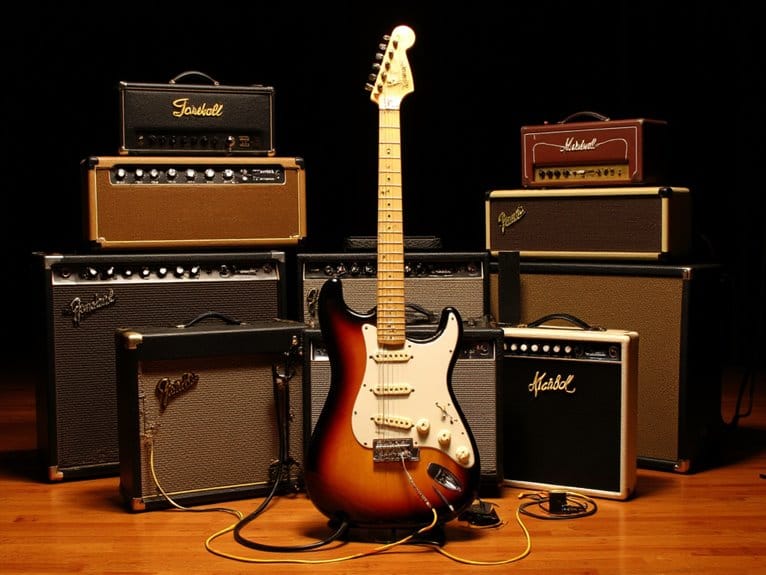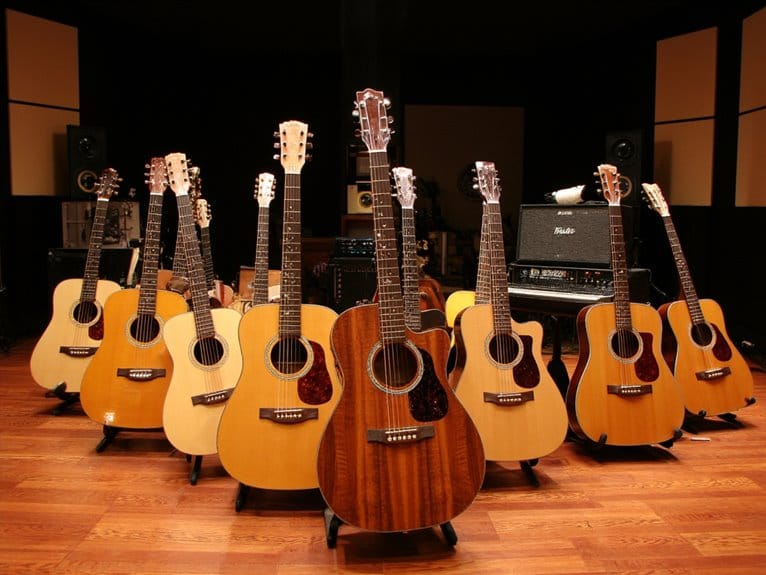Recording Acoustic Instruments at Home: Microphone and Preamp Reviews
As I was setting up my home recording studio, I found that choosing the right microphone and preamp was essential in capturing the true essence of acoustic instruments. The Neumann KM184s, Shure SM81, and Beyerdynamic M160 paired with preamps like the Great River MP2NV or Neve 1073 can truly elevate the quality of your recordings. But there’s more to it than just the equipment – room acoustics, sound treatment, and mic placement techniques all play an important role in achieving that perfect sound. Stay tuned to discover how these elements come together to create professional-grade recordings in a home studio setup. In addition to the microphone and preamp selection, it’s vital to consider the instruments themselves, ensuring they are set up properly and in good condition. Exploring studioready bass amplifier options can also enhance the low-end frequencies, adding depth and richness to the overall mix. With a comprehensive approach to these various aspects, you’ll be well on your way to producing high-quality recordings that rival professional studios.
We are supported by our audience. When you purchase through links on our site, we may earn an affiliate commission, at no extra cost for you. Learn more.
Top Picks for Acoustic Instrument Microphones
When selecting microphones for recording acoustic instruments at home, the Neumann KM184s stand out as top-tier choices due to their exceptional sound quality and transparent characteristics. The Neumann KM184 is a condenser microphone known for its natural sound reproduction and low self-noise, making it ideal for capturing the nuances of acoustic instruments like guitars. Its consistent pickup pattern guarantees a balanced recording, while the flat frequency response captures the instrument’s true sonic profile accurately.
In comparison, the Shure SM81 is another excellent option for recording acoustic instruments. This condenser mic offers a flat frequency response, making it versatile across various instruments. The SM81’s durability and low self-noise make it suitable for instruments such as acoustic guitars, pianos, drums, and strings. Its rugged build assures reliability in home recording setups. Additionally, the SM81 can also serve well as a drum kit mic, capturing the nuances of each drum with clarity. Its ability to handle high sound pressure levels makes it an excellent choice for both live performances and studio sessions. Musicians appreciate its transparent sound, which ensures that the natural tone of each instrument shines through in recordings.
For those looking to capture the delicate nuances of acoustic instruments, the Beyerdynamic M160 ribbon microphone is a top contender. The M160 is renowned for its exceptional sound quality, particularly suited for capturing quiet acoustic passages with finesse. Its unique design and sensitivity make it a valuable addition to any home recording setup focused on acoustic instruments.
Affordable Preamp Options for Home Recording
Exploring cost-effective preamp solutions suitable for home recording setups reveals a range of options tailored to meet different audio production needs. For recording acoustic guitar with budget-friendly preamps, the Behringer UMC22 stands out with its MIDAS-designed mic preamp, ensuring clean audio signals. The Focusrite Scarlett 2i2 is another excellent choice, providing two inputs for versatile recording setups. If you’re looking to add some tube warmth and experiment with variable input impedance for acoustic guitar mics, the ART Tube MP Studio V3 is a solid option. This preamp caters to those seeking a bit of coloration in their recordings.
For those interested in high-quality recordings, the Mackie Onyx Artist 1-2 offers Onyx mic preamps and a remarkable 24-bit/192kHz resolution, ensuring detailed and professional audio captures. On the other hand, the PreSonus AudioBox USB 96 provides a compact and user-friendly solution with its 24-bit/96kHz resolution, suitable for beginners or those needing a portable setup. Each of these entry-level preamps contributes to enhancing the audio quality of your home recordings, offering different features to cater to various preferences and requirements. Choosing the right preamp can greatly impact the overall sound of your acoustic guitar recordings, so choose wisely based on your specific needs and desired audio characteristics.
Comparison of Condenser Vs. Dynamic Microphones
In the domain of audio recording, the choice between condenser and dynamic microphones plays a critical role in shaping the quality and characteristics of captured sound. When comparing condenser and dynamic microphones, several key differences come into play:
- Condenser microphone: Condenser microphones are known for being more sensitive and responsive, making them ideal for capturing a wider range of frequencies. They excel in providing detailed and accurate recordings of acoustic instruments.
- Dynamic microphone: Dynamic microphones, on the other hand, are more rugged and versatile. They can handle high sound pressure levels with less sensitivity, making them suitable for live performances or situations where durability is essential.
- Clarity and accuracy: Condenser mics are favored for their clarity and accuracy in reproducing sound, especially in studio settings where precision is crucial.
- Specific application: The choice between condenser and dynamic microphones ultimately depends on the specific needs of the recording environment and the desired sound characteristics. Understanding the strengths and weaknesses of each type is essential for achieving the best results in audio recording projects.
Review of Ribbon Microphones for Acoustic Instruments
One notable characteristic of ribbon microphones, such as the Beyerdynamic M 160 and AEA R44CE, is their ability to capture the nuanced tonal qualities of acoustic instruments with exceptional smoothness and clarity. The Beyerdynamic M 160 is renowned for its smooth bass, mids, and highs, making it an ideal choice for capturing the subtleties of acoustic instruments. Its exceptional sound quality and ability to faithfully reproduce the natural tone of instruments have made it a favorite among recording engineers. On the other hand, the AEA R44CE offers a classic, vintage sound that many recording professionals cherish for its warm and natural tone.
Additionally, the Royer R-121 is a popular ribbon microphone known for its high SPL handling and smooth frequency response, providing excellent detail and depth when recording acoustic instruments. Ribbon microphones, in general, are highly regarded for their capacity to capture the intricate nuances and natural characteristics of acoustic instruments, making them indispensable tools for many recording engineers. The smooth frequency response of ribbon mics like the Beyerdynamic M 160 and AEA R44CE contributes to their ability to deliver a transparent and accurate representation of the sound source, ensuring a faithful recording of the instrument’s tonal nuances.
Essential Techniques for Recording Acoustic Instruments
Selecting the appropriate microphone and preamp is a critical step in capturing the intricate nuances of acoustic instruments during the recording process at home. To guarantee high-quality recordings, here are some essential techniques to ponder:
- Experiment with Mic Placement: Moving the microphone closer or farther from the acoustic instrument can drastically alter the sound captured. Finding the sweet spot is key to achieving the desired tone.
- Understand Polar Patterns: Knowing how different polar patterns like cardioid, figure-8, or omnidirectional affect sound pickup can help in positioning the microphone ideally for capturing the instrument’s unique characteristics.
- Utilize Sound Treatment: Implementing acoustic panels, bass traps, or diffusers in your recording space can minimize unwanted reflections, standing waves, and resonances, leading to clearer recordings with improved sonic detail.
- Pair Microphone with Preamp: Matching the microphone’s characteristics, such as sensitivity and sound pressure levels, with a suitable preamp can enhance the overall signal chain and guarantee clean, transparent amplification of the acoustic instrument’s sound.







